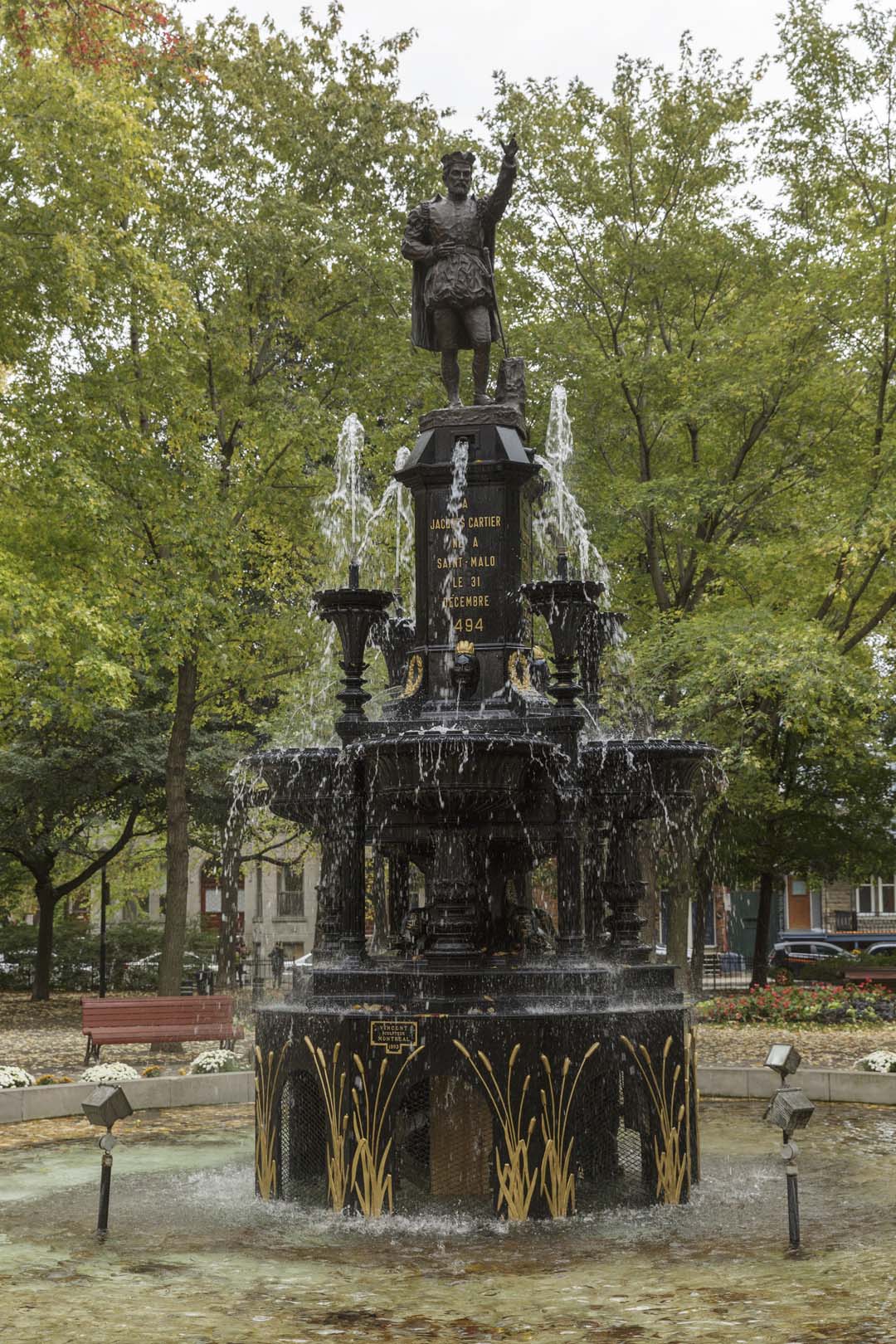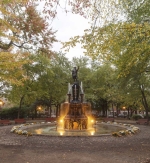Joseph-Arthur Vincent
Monument à Jacques Cartier
1893
Presentation of the artwork
The focal point of Parc Saint-Henri, the monument-fountain is situated in the centre of a pool and stands on an octagonal base decorated with bulrushes. On the base sit four large basins alternating with four small columns topped with cups with fountain jets. In the centre, four beavers hug the base of the pedestal. The top part of the monument has three sections. The bottom one is adorned with foliage branches knotted together with a ribbon and heads of Aboriginals. The middle one bears inscriptions relating episodes in Cartier’s career. The top one is pierced with an opening for the mouth of a large fountain jet. On top of the monument is the sculpture of Cartier, portrayed as a valiant explorer, wearing a cap and the cape and baggy knickers that were in style during the reign of Francis I. His right hand rests on his sword belt and his raised left arm points west. At his feet is a tree stump, the symbol of a country to be cleared. Associated events
The monument commemorates Jacques Cartier. The statue is a likeness of Cartier, and the four plaques that adorn the fountain illustrate moments in his career. Born in Saint-Malo, Cartier (1491–1554) is considered the discoverer of Canada and the first explorer or the St. Lawrence River. In search of a route to Asia, he reached Newfoundland and the Labrador coast in 1534, and he took then took possession of Canada in the name of King Francis I. Cartier took three voyages of exploration, in 1534, 1535, and 1541.
Joseph-Arthur Vincent
A sculptor in wood and modeller, Joseph-Arthur Vincent learned sculpting in the Montréal studio of Charles-Olivier Dauphin from 1865 to 1870. After spending ten years at the Ernest Chanteloup foundry as an artist-designer, Vincent opened his studio in 1879. In 1891-92, he taught modelling and sculpture at the École des arts et métiers de Montréal. His most important artwork is the baldachin at the Mary Queen of the World basilica and cathedral in Montreal (circa 1895).
Presentation of the artwork
The focal point of Parc Saint-Henri, the monument-fountain is situated in the centre of a pool and stands on an octagonal base decorated with bulrushes. On the base sit four large basins alternating with four small columns topped with cups with fountain jets. In the centre, four beavers hug the base of the pedestal. The top part of the monument has three sections. The bottom one is adorned with foliage branches knotted together with a ribbon and heads of Aboriginals. The middle one bears inscriptions relating episodes in Cartier’s career. The top one is pierced with an opening for the mouth of a large fountain jet. On top of the monument is the sculpture of Cartier, portrayed as a valiant explorer, wearing a cap and the cape and baggy knickers that were in style during the reign of Francis I. His right hand rests on his sword belt and his raised left arm points west. At his feet is a tree stump, the symbol of a country to be cleared. Associated events
The monument commemorates Jacques Cartier. The statue is a likeness of Cartier, and the four plaques that adorn the fountain illustrate moments in his career. Born in Saint-Malo, Cartier (1491–1554) is considered the discoverer of Canada and the first explorer or the St. Lawrence River. In search of a route to Asia, he reached Newfoundland and the Labrador coast in 1534, and he took then took possession of Canada in the name of King Francis I. Cartier took three voyages of exploration, in 1534, 1535, and 1541.
Joseph-Arthur Vincent
A sculptor in wood and modeller, Joseph-Arthur Vincent learned sculpting in the Montréal studio of Charles-Olivier Dauphin from 1865 to 1870. After spending ten years at the Ernest Chanteloup foundry as an artist-designer, Vincent opened his studio in 1879. In 1891-92, he taught modelling and sculpture at the École des arts et métiers de Montréal. His most important artwork is the baldachin at the Mary Queen of the World basilica and cathedral in Montreal (circa 1895).






